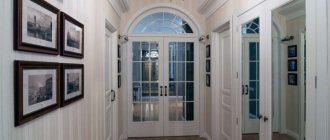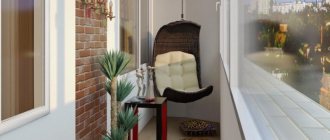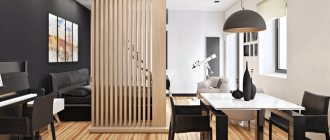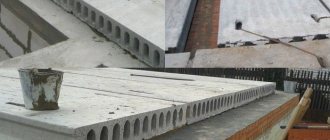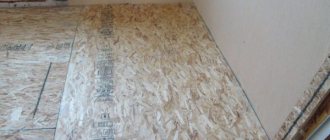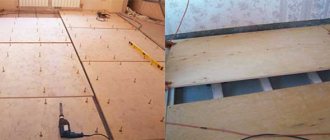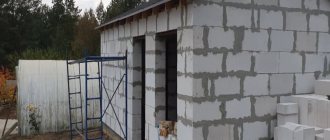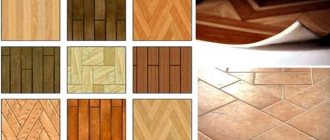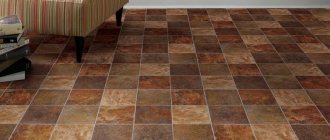Published: 06/10/2012 Heading: Materials and technologies, Construction Views: 127389
Varieties of plates and sheets for covering walls, floors and ceilings
What types of slabs for construction, repair and cladding of walls, floors and ceilings exist? Their features, advantages and disadvantages. If we take frame houses as an example, the durability and appearance of such houses directly depend on the panels used for interior and exterior cladding. Moreover, the use of panels with finished finishing or a layer of thermal insulation (sandwich panel) significantly reduces the already short construction time of a prefabricated frame house.
Chipboard
Chipboard is made by hot pressing wood shavings with binder thermoactive resins, which make up 6-18% by weight of the shavings. Resins are environmentally unsafe because they contain formaldehyde, which is harmful to humans. Based on the content of this substance, chipboards are divided into classes E1 and E2. Class E1 is more environmentally friendly; it is approved for use in the production of even children's furniture. Entirely lined chipboards do not pose any harm to health; only open edges have a harmful effect. New technologies make it possible to produce Super E class slabs, which are considered safe according to all sanitary standards. In general, the material is characterized by a fairly high density, low cost and ease of processing. Chipboard is sheathed on walls, roofs, partitions, floors are made, and used as a base for linoleum and carpeting.
Chipboard
Advantages of chipboard:
- wide range of colors, patterns, thickness;
- easy to process;
- homogeneity of structure.
Disadvantages of chipboard:
- does not hold screws and nails well, especially during reassembly;
- vulnerable to moisture;
- contains carcinogens (for example, melamine).
Aquapanel
Aquapanel is a moisture-resistant sheet composite material based on cement (without asbestos) and mesh fiberglass. As an additive, a mineral filler is used - fine expanded clay, which acts as a “core”. Fiberglass fabric is laid in an even layer over the entire surface of the panel. The edges of the building material have a rounded shape. The product is environmentally friendly due to the absence of asbestos and organic substances. Scope of application – finishing work inside and outside the premises (facades, cladding, partitions). The plate is highly resistant to mechanical stress and high levels of air humidity, so it will not deform during operation. The material is not subject to rotting. The edges of the aquapanel are trimmed and the edges are reinforced. The thickness of the sheet material is 12.5 mm.
Read more about Aquapanels: Application of Aquapanels, operating features and technical characteristics
MDF
Medium density wood board or dry pressed fibreboard. MDF from English (Medium Density Fiberboard). It is made from wood chips, ground into flour by dry pressing, at high temperature and pressure with the addition of lignin, which is found in natural wood. Lignin makes this material environmentally friendly and resistant to fungi and microorganisms. MDF boards come in thicknesses from 3 to 30 mm and are laminated with plastics, varnished or veneered. In terms of moisture resistance and mechanical characteristics, MDF is superior to natural wood and chipboard. MDF is also 2 times stronger and holds screws better. MDF is used for finishing premises, for example, in the form of wall panels or laminated flooring - laminate, in the production of furniture, speaker cabinets. MDF has a homogeneous structure, is easy to process, and very durable.
MDF Medium Density Wood Board or Dry Pressed Fiberboard
Advantages of MDF:
- fire resistance;
- biostability;
- high strength;
- holds screws better than chipboard;
- moisture resistance is higher than that of chipboard;
- wide choice of colors and patterns thanks to film and veneer coating.
Disadvantages of MDF:
- burns with the release of toxic smoke;
- Dust-like sawdust generated during processing and sawing of slabs is harmful to health.
Drywall (GKL)
It is rightfully considered one of the most popular materials for leveling walls, ceilings and floors, installing interior partitions and even decorative elements such as arches, columns, spheroids, multi-level ceiling coverings, etc. The main component of plasterboard sheets is gypsum filler and this determines many of the positive qualities of the building material. Thus, drywall is chemically inert, its acidity is approximately equal to the acidity of human skin, it does not contain and does not release chemical compounds harmful to humans into the external environment. A standard board consists of 93% gypsum dihydrate, 6% cardboard and another 1% surfactants, starch and moisture.
Thus, the fragility of the panels complicates their transportation and loading and unloading operations. For the same reason, gypsum board cannot withstand significant physical stress and is not recommended for leveling floors. Suspended plasterboard ceilings can withstand a weight of no more than 4 kg per square meter, while suspended ceilings can bear a load of more than 100 kg per square meter.
Drywall
A variation or more modern modification of a simple sheet of plasterboard is painted or laminated plasterboard, gypsum vinyl or gypsolam - colored plasterboard with a vinyl coating. A fundamentally new material that has an initially exclusive appearance with a wide selection of decor. It is used for interior wall cladding, for covering window slopes, creating partitions, showcases and exhibition shelving, without additional finishing.
Laminated plasterboard, gypsum vinyl or gypsolam - colored plasterboard covered with vinyl coating
These environmentally friendly non-flammable panels are a gypsum board covered on both sides with special cardboard. They have ideal geometry and are used for constructing internal partitions and lining ceilings. Supplied in sheets 2700 (3000) x 1200 x 12 mm. Special grades of plasterboard are produced for wet (bathroom) and fire hazardous (wall near the fireplace) rooms. They are painted in “signal” colors - red and green. There is also plasterboard of increased plasticity (thickness 6 mm, width 900 mm) for covering rounded walls. Sandwich panels are made from plasterboard with a heat-insulating layer of polyurethane foam (up to 50 mm). They are already used for internal cladding of external walls without subsequent insulation and vapor barrier. This significantly reduces construction time.
Advantages of drywall:
- environmental and sanitary safety;
- easy to process: cut, drill;
- does not burn, but is destroyed when heated significantly;
Disadvantages of drywall:
- low strength, fragility;
- greater vulnerability to moisture, even of a moisture-resistant variety;
- does not tolerate low temperatures and significant temperature changes;
- Suitable for interior decoration only.
Useful tips
Home with full-length siding
- It would be a good idea to ask the seller about additional services provided by the outlet: methods of siding delivery, installation, calculation of the amount of material.
- To calculate the quantity, involve a specialist: after all, like a professional, he has a trained eye. In this case, he will be responsible for measuring and installing the siding.
- If you rely on your calculations, then it is likely that you may still have panels and components left over. Ask the seller in advance whether the store will accept unused leftover goods.
So, you have already studied the question of how to choose siding for the facade. Follow the recommendations given in the article. And all that remains is to buy siding. I would like to hope that you will not have to regret the choice you made.
Plasterboard
Plasterboards are a practical, modern and environmentally friendly material, as they are made without the use of toxic substances from natural gypsum, which does not conduct electricity and is odorless. The plasterboard meets all fire safety requirements. Gypsum board, gypsum tongue-and-groove plate (GGP) is the main material in the construction of partitions, suspended ceilings, and various decorative projections. Used for leveling ceilings, walls, and “sealing” communication systems. Gypsum plaster can be moisture resistant and standard. Standard is used in buildings with normal humidity. Boards with hydrophobic additives are intended for damp rooms. Such slabs are easily distinguished by their characteristic green color.
Gypsoplate, gypsum tongue-and-groove plate (GGP)
Advantages of gypsum boards:
- environmental and sanitary safety;
- easy to process: cut, drill;
- low flammable material, flammability class G1
- relatively cheap.
Disadvantages of plasterboards:
- low strength, fragility;
- greater vulnerability to moisture, even of a moisture-resistant variety.
Gypsum fiber sheet
Gypsum fiber sheet (GVL) is a modern environmentally friendly homogeneous material with excellent technical characteristics. It is produced by semi-dry pressing of a mixture of gypsum and cellulose waste paper. In terms of its physical properties, gypsum fiber sheet is a fairly strong, hard material, also famous for its fire-resistant qualities.
Gypsum fiber sheet, due to its versatility, has become very widespread in the construction industry. It is used for the installation of interior partitions, floor screeds, suspended ceilings, wall cladding and fire protection of structures. GVL for the floor, which is used to assemble the base of the floor covering, is popular, as well as the facing option, with which, for example, wooden surfaces are sheathed, thereby increasing their fire resistance. Depending on the area of application, gypsum fiber sheets are divided into two types: GVLV (moisture resistant) and GVL (regular).
Gypsum fiber sheet. Floor installation
Advantages of gypsum fiber sheets:
- GVL, compared to gypsum plasterboard, can more easily withstand sawing in any direction, since it is homogeneous in composition;
- Higher strength due to cellulose fiber reinforcement;
- Increased sound insulation.
Disadvantages of gypsum fiber sheets:
- Less bending strength than gypsum board;
- Less suitable for interior decoration than gypsum board;
- The need for pre-treatment before painting.
Combined facade finishing options
The variety of modern building materials gives architects and designers almost unlimited opportunities to express their imagination. In principle, a house built using any technology can now be “disguised” as any other structure: a wooden house can be turned into a stone one using high-quality siding or decorative tiles; a brick house, on the contrary, can be sheathed with imitation timber.
An excellent aesthetic effect is achieved by combining textured plaster with stone decorative elements: blades, platbands, balusters of balconies and porches.
Finishing the base with rusticated or wild stone (and their imitations) goes well with the wooden covering of the upper part of the facade.
There are many interesting options, and as an example we will finally consider one of the most exotic and spectacular.
Cement particle boards
Cement particle boards (CPB) are an ideal material for the outer cladding of frames and partitions in wet and flammable rooms, and serve as a good leveling base for any floor coverings. It has a hard and smooth surface, can be plastered and tiled, sawn with a hacksaw, is non-flammable, resistant to moisture and temperature fluctuations. Supplied in sheets 3600 x 1200 x 10 (12, 16, 20 and 26) mm.
Cement particle boards
Description of the material and manufacturing process
Siding refers to panels made of various materials, including PVC, which cover the facade surface of the building, having previously organized the lathing. If we are talking about vinyl sheathing, then it is made by extrusion.
To produce metal, steel sheets are coated with a primer.
And fiber cement requires the use of a cement-fiber mixture. The purpose of the material is not only to improve the appearance of the house, but also to provide additional insulation.
Plywood
Plywood is one of the most common materials widely used in construction. Plywood is produced by gluing together several layers of peeled veneer with phenol-formaldehyde resins. For this purpose, as a rule, birch or coniferous veneer of small thickness is used. The choice of these species is due to their wide distribution in our forests: in Europe, New Zealand and some other countries, oak, maple, hornbeam and even pear are widely used for the production of various types of plywood. Veneer gluing is carried out under pressure at elevated temperatures. The resulting sheets are cooled, and after a short period of curing, they are collected in packages of 10 or 20 pieces.
Depending on the wood and glue used in the production of plywood, it is classified into:
- plywood with increased moisture resistance (FSF)
- medium moisture-resistant plywood (FC)
- bakelized plywood (BF)
Plywood
Laminated plywood is plywood lined on one or both sides with a paper-resin coating. This coating very effectively prevents the penetration of moisture, is highly resistant to abrasion and the formation of mold and mildew, and is resistant to corrosion and destruction. This type of plywood is quite popular due to lamination. Using lamination, you can apply almost any pattern or imitation: oak, poplar, maple, birch, walnut, pine and larch.
Laminated plywood
Advantages of plywood:
- high tensile and bending strength;
- Excellent sawing, drilling and fastening with both nails and screws;
- relatively inexpensive material.
Disadvantages of plywood:
- resins used for gluing veneer contain a fairly high concentration of phenolic compounds;
- flammability;
Plaster facade
This is the most ancient and time-tested method of cheaply finishing the outside of a house. If the plaster is applied according to all construction rules, it will adhere perfectly to the surface, serving as additional insulation and protecting the walls from moisture penetration. Recently, various additives have been developed that expand the variety of textures of the plastered surface and increase resistance to environmental influences.
Appearance
Previously, plaster looked only like a “fur coat” with pronounced “spines”. Then a new species appeared - the “bark beetle”, characterized by grooves “gnawed” by termites. Now plaster can imitate loft concrete, brickwork, cut wood and other materials.
Price
The cost of finishing a private house with plaster on the outside consists of the following work:
- installation of insulation;
- applying a plaster layer;
- applying a decorative layer
- painting.
For all work you will have to pay about 1800 rubles/m². If you need a decorative finishing layer with a pattern or stone inserts, then the price for the work increases even more. The materials themselves - plaster mortar, decorative plaster, paint - will cost approximately 1,900 rubles per sq. m.
Durability and practicality
If everything is done correctly, the plaster will be resistant to temperature fluctuations, precipitation and shock. It can serve on the facade of a private house for decades. To update the look of a building, simply repaint it with a spray paint.
But violation of the application technology (for example, too thick a layer) or the use of low-quality materials leads to the rapid formation of cracks, loss of entire pieces, and the appearance of stains. Therefore, the process must be carried out by professionals, otherwise the finish will not last long.
Care
Washing with water without strong pressure is allowed. You can repaint it with a spray gun or roller if the surface is not too textured.
Oriented Strand Board
Oriented strand board (OSB) produced by pressing chips up to 0.7 mm thick and up to 140 mm long under high pressure and temperature using a small amount of adhesive resin. OSB boards are 3 times stronger than chipboard and MDF boards due to the arrangement of chips longitudinally in the outer layers and transversely in the inner ones. With such strength, OSB is a very flexible material and is excellent for construction and finishing work. OSB boards of various thicknesses (from 6 to 30 mm) are used to sheathe attics, ceilings, walls, and are used to make subfloors, formwork, wall panels, fences and collapsible structures. For laminate flooring, the thinnest slabs are usually used - 6 and 8 mm thick, for structures and formwork thicker ones - from 10 mm. OSB-3 is a more durable version of this material, used in low-rise construction in conditions of high humidity. Also, because of its original texture, OSB is a favorite material among decorators and designers for interior decoration. OSB makes a fairly impressive design for the ceiling or elements in built-in furniture or walls.
OSB Oriented Strand Board
Along with conventional OSB boards, there is also tongue-and-groove OSB - a board with machined groove and tongue ends, on 2 or 4 sides.
OSB tongue and groove - board with machined ends groove - tongue
Advantages of OSB:
- strength relative to other slabs used;
- moisture resistance is higher than that of chipboard and gypsum board;
- wide size range;
- cheaper than chipboard;
- holds screws well, even when screwing in again.
Disadvantages of OSB:
- it is processed worse than chipboard due to the heterogeneity of the structure;
- dust released when cutting OSB irritates the mucous membranes of the nose and eyes.
- contains formaldehyde, especially in moisture-resistant boards.
How to cover the outside of a house: review of materials
Among the facing materials used in Russia, it is necessary to highlight several of the most popular ones. These have already become traditional
- siding
- facade panels.
- brick
- stone
- plaster
As well as innovative types of cladding:
- flexible wall tiles
- fiber cement siding
- foam siding.
To choose finishing materials for the facades of houses, we will analyze each of them in more detail according to their key qualities and benefits.
Glass magnesium sheet
Glass-magnesium sheet or glass-magnesite sheet (SML) is white, reinforced with fiberglass, 40 percent lighter than GVL, flexible, durable, fire-resistant, moisture-resistant. Thanks to the reinforcing fiberglass mesh, the SML can bend with a radius of curvature of up to three meters. This quality allows it to be used on uneven surfaces. High moisture-resistant qualities allow it to be used in rooms with high humidity. Any finishing materials can be glued to the front side of the slab. With a sheet thickness of 6mm, it is capable of holding fire for 2 hours and can withstand heating up to 1500 degrees. Sheet thickness: 3-20 mm.
Glass-magnesium sheet (FMS) is a universal sheet finishing material based on magnesite and fiberglass. The manufacturing technology and composition of the material give it such qualities as flexibility, strength, fire resistance and moisture resistance. Its qualities allow it to be used on uneven surfaces and reduces the possibility of sheet fracture during installation and transfer. In addition, this material is environmentally friendly, does not contain harmful substances and asbestos, and does not emit toxic substances even when heated. Unlike plasterboard, SML-Premium class belongs to low-combustibility materials (NG).
The scope of application of glass-magnesium sheet is extremely high. Like plasterboard, it can be used to make ceilings, walls and interior partitions. Moreover, glass-magnesite sheets can be used to decorate the external facades of cottages and houses. SML is a reliable basis for any type of finishing. The new material is ideal for showers, saunas, and swimming pools - after all, the glass-magnesium sheet can withstand high humidity, temperature changes and open fire. A wide variety of putties, paints, and adhesives can be applied to the surface of LSU. You can stick wallpaper, aluminum-composite panels, veneer, plastic, ceramic, glass or mirror tiles.
The front (smooth) surface of the sheets is intended for painting, wallpapering, laminating and applying various types of decorative textures without preliminary, final puttying and priming of the entire surface of the material. The back (rough) surface of the sheets is intended for strong adhesion when gluing piece facing and decorative materials (ceramic or tiles, veneer, etc.), or the material itself to walls and floors, gluing sheets together. LSU can be mounted on a mounting system made of both metal and wood. And also directly onto the enclosing structure using glue.
laminated glass-magnesium sheets with a variety of patterns and thickness of the outer coating have recently begun to appear more and more often
SML Glass magnesium sheet, glass magnesite sheet or glass magnesite
Advantages of glass magnesite:
- Moisture resistance - does not undergo deformation, does not swell and does not lose its properties;
- Fire resistance - magnesite panels are non-flammable material;
- Good sound insulation - a 12mm panel in terms of sound permeability corresponds to four layers of twelve millimeter plasterboard sheet, or a 150mm thick brick wall;
- High strength and flexibility - can bend with a radius of curvature from 25 cm to 3 meters;
- Lighter than similar slabs made of wood or gypsum;
- Low thermal conductivity, can be used as additional insulation;
- Can be used for finishing both outside and inside.
Disadvantages of glass magnesite:
- More fragile than gypsum fiber sheet;
- When filling joints, it is necessary to use putties with chemical adhesives;
- Properties vary significantly depending on the manufacturer and class of LSU.
Vinyl siding
The material is made from PVC (it makes up 80%) and additional additives designed to improve performance. Early batches of extruded siding quickly lost color and were quite fragile. This shortcoming has now been partially corrected. Vinyl siding goes well on the facade of the house with basement siding, made from the same material, only of increased thickness.
Vinyl siding panel.
Appearance
It is one of the most affordable materials, which is why it can often be seen on houses in gardening communities, cottages or villages. But cottages are decorated with it much less often. Recently, technology for the manufacture of vinyl siding has made great strides forward and now it more and more accurately imitates stone or brickwork. The material is produced in panels with holes for installation around the perimeter, covered by the next level.
The rough surface, relief cracks and chips with shells make it almost identical to natural materials when viewed from a distance of 5-7 m. Up close, the differences are more visible, but the product is successfully popular as inexpensive house cladding.
The house is covered with vinyl siding.
Price
Vinyl siding is actively purchased for the exterior decoration of cottages, grandma's house in the village and other buildings. It masks defects in the walls well, giving the house a new look. The product is sold in panels with snap holes fixed to the sheathing. Price of plastic siding per 1 sq. m. it comes out to 400-500 rubles. They charge about 500 rubles for the work to lay an area of 1 square meter.
But this is not the full cost. Installation will not work without additional elements, which are used to attach siding strips and are much more expensive:
- wind bar - 1200 rubles;
- starting profile - 1100 rub.
Durability and practicality
Despite its low cost, the material for house cladding has clear advantages. It does not rot under high humidity and prolonged precipitation. It tolerates temperatures well down to -50º C and up to +50º C. It lasts quite a long time.
But the budget cost affected the strength and color retention. Plastic siding is fragile and can crack if accidentally hit with the handle of a shovel. Most often this happens at sub-zero temperatures outside, when snow is being cleared nearby. It is not uncommon for siding to be damaged by large hail.
Vinyl siding damaged by hail.
The surface also fades quickly in the sun. True, this happens evenly, so it is not very noticeable, but in 5 years the facade of the house will become much lighter. White, yellow or beige siding is least susceptible to fading. Inorganic pigments are now added to some types of vinyl to retain color, but such panels are more expensive.
Care
A rough surface quickly accumulates dust and dirt. It is especially noticeable on light types of siding. Care involves washing with water from a hose, without using abrasives. If this is done with a Karcher with increased pressure, the cleaning speed increases.
Vinyl siding is dirty.
Maintainability
Technically, replacing one cracked panel is not difficult and cheap. But since the surface fades, the new element will stand out from the rest, and you will have to replace the panels on the entire wall so that there is no difference in color.
Fiberboard boards
Fibrolite is a board material made by pressing special wood fiber (wood wool) and an inorganic binder (magnesium binder). The fiber is obtained from waste from the wood processing industry, as a result of processing on wood planing machines. One of the advantages of fiberboard boards is their low volumetric weight. Fiberboard is fire resistant: the shavings are impregnated with cement, and when exposed to fire, only soot is formed. The material allows for various finishing options, is easily attached to any structure using nails, screws, dowels, and can be easily sawed.
Fiberboards are a fire-resistant, bioresistant material that is used as thermal insulation, structural, thermal insulation and acoustic materials in building structures of buildings and structures with a relative air humidity of no higher than 75%.
Conventional fiberboard boards are produced with a thickness of 3-5 mm using gray cement as a binder. These boards are used for various types of thermal insulation, when constructing roofing and plastered partitions. Acoustic slabs are usually made from fine wood wool (0.75-2 mm), which improves their appearance, are not covered with anything, and are also tinted in colors that harmonize with the interior or are made using magnesite or white cement instead of gray. A composite fiberboard panel is a two- or three-layer panel with a middle layer of thermal insulation material, such as rigid foam or mineral fiber (mineral silicate wool). The thickness of the middle layer usually ranges from 15 to 140 mm, although the outer layers of fiberboard range from 5 to 20 mm in thickness. In this case, the level of thermal insulation increases significantly.
Fiberboard boards
Advantages of fiberboard boards:
- Ease of installation;
- Good insulation;
- Mechanically strong;
- Extensive decorative possibilities;
- Good moisture resistance and fire resistance;
- Soundproofing;
- Hygiene, harmless to human health and the environment;
- Do not spoil rodents and insects, does not rot.
Disadvantages of fiberboard boards:
- Low bending strength;
- Considerable weight.
Feel free to comment on the article if you have anything to add to this material. If you find errors or inconsistencies. Perhaps you know some other similar material not presented in this article?
These articles may also be of interest to you:
- Plates and sheet materials for subfloor construction
- Drywall - types and application features
- Installation of facade blocks
- Original small kitchen design
What else would you like to read?
Tags: OSB, GVL, gypsum tongue-and-groove board, gypsum vinyl, Gypsum fiber sheets, Drywall, gypsum board, Gypsum board, Medium density wood board, Chipboard, chipboard, laminated plasterboard, MDF, Oriented strand board, OSB, tongue-and-groove OSB, SML, glass-magnesite sheet, glass-magnesium sheet, plywood, fiberboard, fiberboard boards, cement-bonded particle boards
Metal siding
These are steel panels coated with galvanization and a polymer layer that perform a protective function. This prevents the metal from rusting and is responsible for the beauty of the façade material.
Metal siding strip under timber.
Metal siding strip for a blockhouse.
Appearance
Steel siding is available in a variety of designs and colors, imitating natural wood, blockhouse, board, and timber. But this is achieved only through the design, and the surface itself is without texture and very smooth. The width of the board varies from narrow planks to solid planks.
The house is covered with metal siding and imitates a blockhouse.
The house is covered with metal siding with imitation logs.
The house is covered with metal siding with imitation timber.
Price
The cost of metal siding is higher than vinyl siding and depends on the cross-section of the steel sheet used. The thinnest is 0.4 mm, and the thickest is 0.5 mm. The price varies from 600 to 800 rubles. for 1 m².
Durability and practicality
Metal siding will not crack when hit with a shovel, but a dent will remain, spoiling the appearance of the facade. If the outer polymer layer is damaged, corrosion will begin. In this regard, it is important to take extra care during installation so as not to scratch the surface with the tool.
Corrosion on metal siding.
Due to the thin metal, the exterior trim sways a little in the wind and hums. During slanting rain, additional noise may occur from drops that fall and break on the siding. You get the impression that you are in a tin can. The use of sound insulation has a positive effect, but not a big one. There are reinforced types of metal siding with a polyurethane foam backing, but they are much more expensive. One of the advantages of the material is a long service life of up to 50 years.
Care
Since the surface has no roughness, the material can be washed simply with water from a hose. It is enough just to water the wall from top to bottom and the dirt flows off, leaving the house clean from the outside.
Maintainability
To replace one damaged panel, you will need to dismantle all the others located on this wall.

